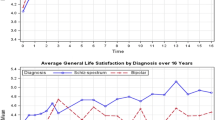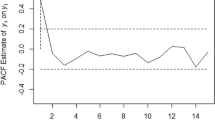Abstract
The purpose of this article is to illustrate, for those unfamiliar with the methods, concomitant time series analyses and their utility in psychopathology research. In a case involving somatoform disorder, we offer a detailed illustration of these analytic procedures where hypotheses regarding psychosocial antecedents of somatic symptoms are tested. Also portrayed are methods for describing across-time trends and cycles in longitudinal data. Included is a discussion of other clinical questions amenable to a time series approach, as well as a consideration of practical issues in the design of such studies.
Similar content being viewed by others
References
Aiken, L. S., West, S. G., Sechrest, L., & Reno, R. R. (1990). Graduate training in statistic methodology, and measurement in psychology: A survey of PhD programs in North America.American Psychologist, 45, 721–734.
American Psychiatric, Association (1987).Diagnostic and statistical manual of mental disorders (3rd ed., rev.). Washington, DC: Author.
Barnett, P. A., & Gotlib, I. H. (1988). Psychosocial functioning and depression: Distinguishing among antecedents, concomitants, and consequences.Psychological Bulletin, 104, 97–126.
Beck, A. T., Epstein, E., Harrison, R. P., & Emery, G. (1983).Development of the Sociotrophy-Autonomy Scale: A measure of personality factors in psychopathology. Unpublished manuscript, University of Pennsylvania, Philadelphia.
Box, G. E. P., & Jenkins, G. M. (1976).Time-series analysis: forecasting and control (rev. ed.). San Francisco: Holden-Day.
Brockwell, P. J., & Davis, R. A. (1991).Time series: Theory and methods (2nd ed.). New York: Springer-Verlag.
Bryk, A. S., & Raudenbush, S. W. (1991).Hierarchical linear models for social and behavioral research: Applications and data analysis methods. Newbury Park, CA: Sage.
Burman, B., & Margolin, G. (1992). Analysis of the association between marital relationships and health problems: An interactional perspective.Psychological Bulletin, 112, 39–63.
Catalano, R. A., Dooley, D., & Jackson, R. (1983). Selecting a time-series strategy.Psychological Bulletin, 94, 506–523.
Cohen, S., & Williamson, G. M. (1991). Stress and infectous disease in humans.Psychological Bulletin, 109, 5–24.
Collins, L. M., & Horn, J. L. (Eds.). (1991).Best methods for the analysis of change: Recent advances, unanswered questions, future directions, Washington, DC: American Psychological Association.
Cook, T., & Campbell, D. (1979).Quasi-experimentation: Design and analysis issues for field settings. Boston: Houghton Mifflin.
Cook, T. D., Dintzer, L., & Mark, M. M. (1980). The causal analysis of concomitant time series.Applied Social Psychology Annual, 1, 93–135.
Derogatis, L. R., & Spencer, P. M. (1982).The Brief Symptom Inventory: Administration, scoring, and procedures manual I. Baltimore: Clinical Psychometric Research.
Dunn, N. J., Jacob, T., Hummon, N., & Sielhamer, R. A. (1987). Marital stability in alcoholic-spouse relationships as a function of drinking pattern and location.Journal of Abnormal Psychology, 96, 99–107.
Epstein, S. (1979). The stability of behavior: I. On predicting most of the people much of the time.Journal of Personality and Social Psychology, 37, 1097–1126.
Epstein, S. (1980). The stability of behavior: II. Implications for psychological research.American Psychologist, 35, 790–806
Games, P. A. (1990). Alternative analyses of repeated-measures designs by ANOVA and MANOVA. In A. von Eye (Ed.),Statistical methods in longitudinal research (Vol. 1, pp. 81–121). New York: Academic Press.
Glass, G. V., Willson, V. L., & Gottman, J. M. (1975).Design and analysis of time-series experiments. Boulder: Colorado Associated University Press.
Gollob, H. F., & Reichardt, C. S. (1987). Taking account of time lags in causal models.Child Development, 58, 80–92.
Gollob, H. F., & Reichardt, C. S. (1991). Interpreting and estimating indirect effects assuming time lags really matter. In L. M. Collins & J. L. Horn (Eds.),Best methods for the analysis of change: Recent advances, unanswered questions, future directions (pp. 243–263). Washington, DC: American Psychological Association.
Gottman, J. M. (1981).Time series analysis: A comprehensive introduction for social scientists. New York: Cambridge University Press.
Haugh, L. D., & Box, G. E. P. (1977). Identification of dynamic regression (distributed lag) models connecting two time series.Journal of the American Statistical Association, 72, 121–130.
Hokanson, J. E., & Butler, A. C. (1992). A cluster analysis of depressed college students' social behaviors.Journal of Personality and Social Psychology, 62, 273–280.
Hokanson, J. E., Stader, S. R., Flynn, H. A., & Tate, R. L. (1992).The Daily Experiences Survey: An instrument for daily recordings of multiple variables associated with psychopathology. Unpublished manuscript, Florida State University, Tallahassee.
Johnston, J. (1984).Econometric methods. New York: McGraw-Hill.
Joreskog, K. G. (1979). Statistical models and methods for analysis of longitudinal data. In J. Magidson (Ed.),Advances in factor analysis and structural equation models (pp. 129–169). Cambridge, MA: Abt Books.
Kendall, P. C., & Watson, D. (Eds.). (1989).Anxiety and depression: Distinctive and overlapping features. New York: Academic Press.
Kenny, D. A. (1979).Correlation and causation. New York: Wiley-Interscience.
Larsen, R. J. (1987). The stability of mood variability: A spectral analysis approach to daily mood assessments:Journal of Personality and Social Psychology, 52, 1195–1204.
Larsen, R. J. (1989). A process approach to personality psychology: Utilizing time as a facet of data. In D. M. Buss & N. Cantor (Eds.)Personality psychology: Recent trends and emerging directions (pp. 177–193). New York: Springer-Verlag.
Larsen, R. J. (1990). Spectral analysis of psychological data. In A. von Eye (Ed.),Statistical methods in longitudinal research (Vol. 2, pp. 319–349). New York: Academic Press.
Larsen, R. J., & Kasimatis, M. (1990). Individual differences in entrainment of mood to the weekly calender.Journal of Personality and Social Psychology, 58, 164–171.
Larsen, R. J., & Kasimatis, M. (1991). Day-to-day physical symptoms: Individual differences in the occurrence, duration, and emotional concomitants of minor daily illnesses.Journal of Personality, 59, 387–424.
Lazarus, R. S. (1978). A strategy for research on psychological and social factors in hypertension.Journal of Human Stress, 4, 35–40.
Levor, R. M., Cohen, M. J., Naliboff, B. D., McArthur, D., & Heuser, G. (1986). Psychosocial precursors and correlates of migraine headache.Journal of Consulting and Clinical Psychology, 54, 347–353.
Ljung, G. M., & Box, G. E. P. (1978). On a measure of lack of fit in time series models.Biometrika, 65, 297–303.
McCleary, R., & Hay, R. A. (1980).Applied time-series analysis for the behavioral sciences. Beverly Hills, CA: Sage.
McMillan, M. J., & Pihl, R. O. (1987). Premenstrual depression: A distinct entity.Journal of Abnormal Psychology, 96, 149–154.
Monroe, S. M., & Simons, A. D. (1991). Diathesis-stress theories in the context of life stress research: Implications for the depressive disorders.Psychological Bulletin, 110, 406–425.
Muthen, B. O. (1991). Analysis of longitudinal data using latent variable models with varying parameters. In L. M. Collins & J. L. Horn (Eds.),Best methods for the analysis of change: Recent advances, unanswered questions, future directions (pp. 1–17). Washington, DC: American Psychological Association.
O'Leary, A. (1990). Stress, emotion, and human immune function.Psychological Bulletin, 108, 363–382.
Pankratz, A. (1991).Forecasting with dynamic regression models. New York: John Wiley & Sons.
Priestley, M. B. (1981).Spectral analysis and time series. New York: Academic Press.
Stone, A. A., Kessler, R. C., & Haythornthwaite, J. A. (1991). Measuring daily events and experiences: Decisions for the researcher.Journal of Personality, 59, 575–608.
Tate, R. L., & Hokanson, J. E. (1993). Analyzing individual status and change with hierarchical linear models: Illustration with depression in college students.Journal of Personality, 61, 181–206.
Tennen, H., Sulls, J., & Affleck, G. (Eds.). ({dy1991}). Personality and daily experience. {jtJournal of Personality}, {vn59} ({snWhole No. 3}).
Tzelgov, J., & Henik, A. (1991). Suppression situations in psychological research: Definitions, implications, and applications.Psychological Bulletin, 109, 524–536.
von Eye, A. (Ed.). (1990a).Statistical methods in longitudinal research: Vol. I. Principles and structuring change. New York: Academic Press.
von Eye, A. (Ed.). (1990b).Statistical methods in longitudinal research: Vol. II. Time series and categorical longitudinal data. New York: Academic Press.
Weisberg, S. (1980).Applied linear regression. New York: John Wiley & Sons.
Weisse, C. S. (1992). Depression and immunocompetence: A review of the literature.Psychological Bulletin, 111, 475–489.
West, S. G., & Hepworth, J. T. (1991). Statistical issues in the study of temporal data: Daily experiences:Journal of Personality, 59, 609–662.
Wheeler, L., & Reis, H. T. (1991). Self-recording of everyday life events: Origins, types, and uses.Journal of Personality, 59, 339–354.
Wilkinson, L. (1991).SYSTAT 5.0: System for statistics [Computer program]. Evanston, IL: Systat, Inc.
Youngren, M. A., Zeiss, A., & Lewinsohn, P. M. (1975).The Interpersonal Events Schedule. Unpublished manuscript, University of Oregon, Eugene.
Author information
Authors and Affiliations
Additional information
The authors gratefully acknowledge the helpful comments of Richard Wagner, Edwin Megargee, Stephen West, Associate Editor Diane Arnkoff, and an anonymous reviewer.
Rights and permissions
About this article
Cite this article
Hokanson, J.E., Tate, R.L., Niu, X. et al. Illustration of concomitant times series analyses in a case of somatoform disorder. Cogn Ther Res 18, 413–437 (1994). https://doi.org/10.1007/BF02357752
Issue Date:
DOI: https://doi.org/10.1007/BF02357752




